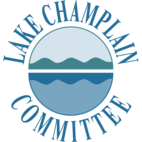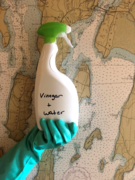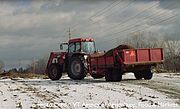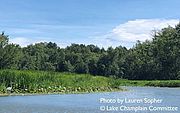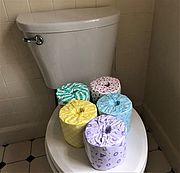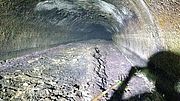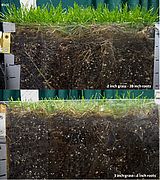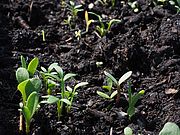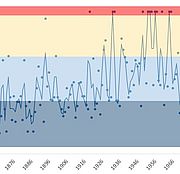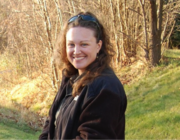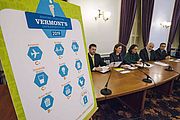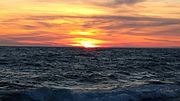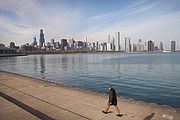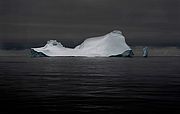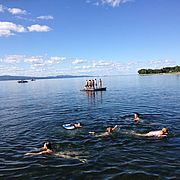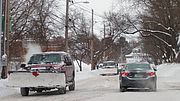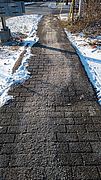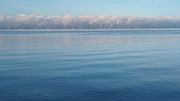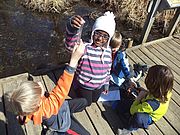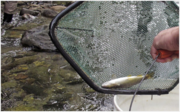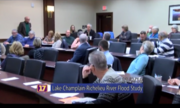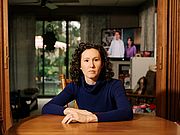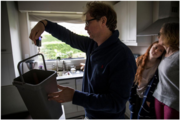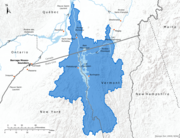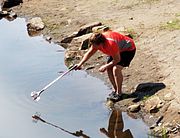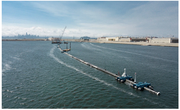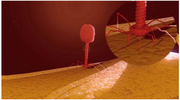Every space gets dirty. Whether at home, at work, or somewhere in between, most of us use cleaning products on a regular basis to tidy up. While commercial products may get things squeaky clean, they can also do more harm than good. Many contain ingredients that can be acutely toxic; carcinogenic or mutagenic; irritating to skin, eyes or lungs; non-biodegradable; poisonous to aquatic organisms; or water and air polluting. Some common components of store bought cleaners to watch out for include ammonium, formaldehyde, glycol ethers, sodium borate, sodium laureth sulfates along with artificial colors, dyes and fragrances.
Read...News from Selected Category
A coalition of Environmental organizations—the Lake Champlain Committee (LCC), Conservation Law Foundation (CLF), Vermont Natural Resources Council (VNRC), and Vermont Audubon—issued a water quality-related press release on December 13, 2019.
Read...Protecting wetlands is a longstanding priority for the Lake Champlain Committee (LCC). The areas of interface between shoreland and water are a vital part of Lake Champlain’s ecosystem. Thank you for using your voice to protect Vermont’s wetlands now and into the future by contacting our legislators! We need a modern goal of a net gain in acres of wetlands through protection and restoration.
Read...Wastewater treatment and septic systems are designed to handle the four Ps—pee, poop, puke, and (toilet) paper—and nothing else. Flushing other paper products, plastics, disposable diapers, pharmaceuticals, dryer lint, condoms, tampons or applicators, or flotsam and jetsam is a big no-no. Wipes clog pipes, even if they are marketed as “flushable".
Read...Fatbergs have become commonplace in city sewer systems around the world. They are an accumulation of fat, oil, and grease congealed around common household solid waste items like “flushable” wipes, paper towels, and tampons. The removal of fatbergs places a financial burden on cities.
Read...Grass is the largest irrigated crop in the United States. It covers city parks, suburban lawns, and wide-open rural fields. Unfortunately, grass can be a major source of fertilizer runoff. While the best way to slow rainwater down and allow pollutants to settle out is to plant native grasses, shrubs, and trees instead of the traditional lawn, there are still things you can do to make your lawn green, healthy, and watershed friendly.
Soil isn’t just the dirt we might think of when we wash our hands or take our shoes off at the door. Healthy soil is alive – it’s full of layered root systems, microbial communities, organic matter, worms, bugs, and fungi. It’s an entire ecosystem that powers all life above it. It can sequester carbon, hold water, and support healthy plant life – all of which are vital to turning the tide on climate change. And, most importantly for Lake Champlain’s water quality, soil with just a 1% increase in organic matter in the top six inches can hold over 20,000 gallons of water per acre.
One of the best-understood facets of climate change is that global temperatures are rising overall. Since the turn of the 20th century we know that average temperatures have gradually risen every decade, and they will continue to rise more rapidly throughout the 21st century. Due to warming winter temperatures, Lake Champlain does not ice over as often as it did even 20 years ago. The freezeover that happened this month is now a rare and celebrated event. Read...
If your faucet drips or your toilet runs it can waste over 10,000 gallons a year -- the amount of water in a typical backyard swimming pool. More than one trillion gallons of water are lost annually in the U.S. due to easy-to-fix household leaks. Read...
Teachers at J.J. Flynn Elementary School in Burlington, VT got creative in their World Water Day class project by partnering with Generator Makerspace, a non-profit in Burlington that bridges the intersection of art, science, and technology. With the technical support of Generator Makerspace, students learned to transform their drawings into laser-cut wood mosaics backed by colorful rice paper.
Plastics are everywhere. The stuff has made modern life possible, but more than 40% of plastics are designed for single use. Plastics are showing up in our waterways at an alarming rate, flushed down sinks and toilets in scrubbing agents, wet wipes and sanitary products; spun off as microfibers from clothes in the wash; and carried into waterways by wind and rain.
Read...In its 2019 report card, the Vermont section of the American Society of Civil Engineers (ASCE) gave the state’s infrastructure a “C” – the same grade it earned in the last report card five years ago. The report was broken down into several areas of infrastructure, with stormwater and wastewater infrastructure both receiving a D+, the lowest grades of the report. Civil engineers identified that the state is facing over a billion dollars in investment gaps over the next 20 years for stormwater alone.
The Great Lakes are one of the world’s largest fresh water sources, covering over 750 miles across eight states. However, a recent investigation by Great Lakes Today and American Public Media reveals that the cost of water has doubled, and even tripled, in cities surrounding the lakes. According to this investigation, there have been hundreds of thousands of water shutoffs to homes and businesses since 2010. On top of having to pay the full water bill to restore service, there are often extra fees for shutting it off and turning it back on. For the average individual, losing water service can be the beginning of a downward spiral.
The growing water crisis in America has forced hundreds of thousands to endure weeks, and even months, without water. This crisis is especially dire where you would least expect it – in the Great Lakes region, the most abundant source of fresh water in the country. With the federal government cutting water infrastructure funding, cities have turned to raising water bills to cover the costs of aging infrastructure. These rising costs hit poor families the hardest, with disproportionately high concentrations of water shut-offs in poorer areas, and majority black and Latino neighborhoods, in every city.
According to a report released by the Rhodium Group, a private climate-research firm, carbon dioxide emissions in the U.S. increased by roughly 3.4% in 2018 – this after three years of decline. The report points to a particularly cold winter and economic growth as the main contributors. While this appears to pit climate change reductions against economic growth, it’s entirely possible to lower emissions while improving the economy. Climate change is a leading contributor to many expensive environmental issues, including increased cyanobacteria blooms, stormwater runoff, and other water quality concerns.
In his January 24, 2019 Budget Address, Vermont Governor Phil Scott proposed using a portion of the Estate Tax to fund water projects. We applaud the Governor’s commitment to long-term clean water funding, but we are concerned with the proposal he advanced because the tax is variable and moves around existing funds in the state budget. For several years LCC has been working as a member of the Vermont Water Caucus to advance state environmental policy. Read...
After winter storm Harper dumped over two feet of snow in parts of the Lake Champlain watershed, followed by more precipitation in the form of freezing rain, the roads were slick from both snow and ice. The few cars braving the weather might find themselves outnumbered by plows, earthmovers, and dump trucks. While the sudden appearance of plows and clear roads after a storm may seem like magic, the snow removal process takes careful planning. Even before the Lake Champlain basin’s heavy snow comes down, or freezing rain coats the roads, municipalities are already swinging into action.
Salt is the ubiquitous solution to icy roads and sidewalks, but it isn’t the only way you can keep from slipping during the winter. Excessive use of salt damages plants’ ability to absorb nutrients, and can affect aquatic life if it’s washed into a water body.
Join LCC, ECHO, and other members of the Clean Water Policy Network on Monday (1/28/19) morning for a discussion of clean water issues and upcoming legislation. The January forum in Montpelier provides participants with a preview of issues, legislation, and regulatory initiatives in the coming session.
World Water Day celebrates the importance of water around the world. In the Lake Champlain watershed we will be celebrating World Water Day on March 21, 2019 with a K-12 student contest! The contest will be hosted at the Main Street Landing Performing Arts Center in Burlington, VT. All student submissions of original art, videos, photography, and writing will be gathered for public viewing from 4:00 – 6:30 PM, awards will be given to winning submissions, and guest speaker Dr. Danielle Garneau, Associate Professor of Environmental Science at SUNY Plattsburgh, will present on “Plastics in Lake Champlain: How you can help”.
Biologists in Montpelier, VT question if a warm, dry fall is to blame for a drop in the Lake Champlain watershed’s landlocked salmon population – or whether there’s another reason. Salmon in the region have been declining for the past five years, and in 2018 their population was the lowest it’s been since 2009.
Recent public meetings were held to provide an update and get citizen input on the Lake Champlain-Richelieu River Flood Study which began in 2017 and will be completed in 2021. LCC’s Executive Director serves on the Public Advisory Group for the study. If you missed these meetings you can catch up on developments by watching the one held in Vermont online!
A mass die-off has caused many of the invasive alewife fish to wash up at Rossetti park just before New Year. Thousands of the tiny herring coated 100 square feet of the lake’s waterline. According to VT Fish and Wildlife fishery scientist Shawn Good, the die-off is the natural result of the alewife’s sensitivity to fluctuations in temperature. Colchester Sun.
“PARCHMENT, Mich. — The day this small town told its residents to stop drinking the water, life on Glendale Boulevard turned from quiet to alarming.” For years calls for polyfluoroalkyl and perfluoroalkyl substances, or PFAS, to be federally regulated have gone unanswered. This summer one more small town paid the price. Washington Post.
“Dr. Natalia Ivleva, a researcher with the Technical University of Munich (TUM), has developed new analytical methods for the identification and quantification of microplastic. In this interview, she shares her latest findings.” Environmental News Network.
“Most people’s New Year’s resolutions are all about self-improvement: exercising more, saving money, learning new skills. This year, enlist your family in a group resolution: reducing your single-use plastic waste.” National Geographic.
Interested in Lake Champlain’s past, present and future? Sign up soon to join LCC at The Lake Between (Le lac qui nous unit) – an International Conference designed to bring together academics, business leaders, policy-makers, outdoor enthusiasts, boaters and swimmers, musicians and artists to talk about the lake.
Deep thanks to all our cyanobacteria monitors for their diligent work during the 2018 season. Many began assessing site conditions in mid-June and filed their final report 19 weeks later in mid-October. LCC monitors and our partners at the Vermont and New York Departments of Health and Environmental Conservation gathered data from nearly 150 sites in the Lake Champlain watershed and filed more than 1,800 reports about water conditions.
The New York Times - "A multimillion-dollar floating boom designed to corral plastic debris littering the Pacific Ocean deployed from San Francisco Bay on Saturday as part of a larger high-stakes and ambitious undertaking."
Water World - "To rapidly detect the presence of E. coli in drinking water, Cornell University food scientists now can employ a bacteriophage - -a genetically engineered virus -- in a test used in hard-to-reach areas around the world."
